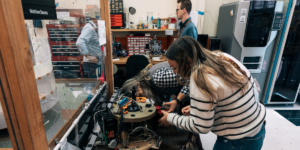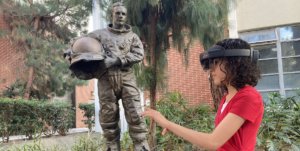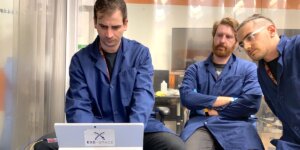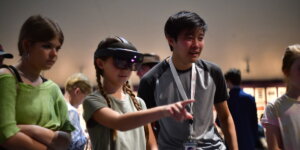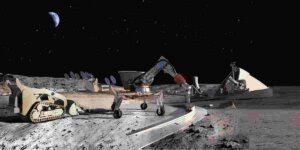NASA will be heading back to the Moon by 2024 through the Artemis program, and USC Viterbi School of Engineering students and faculty are helping plan the party.
A key part of the Artemis program, the Artemis Student Challenges initiative includes almost $2.4 million in grants from NASA that were awarded to various universities, including USC, to inspire and engage students to participate in the Artemis program. As director of USC’s Space Engineering Research Center (SERC), a joint effort between the Information Sciences Institute (ISI) and the USC Viterbi Department of Astronautical Engineering (ASTE), David Barnhart is helping lead USC’s contribution to the program. This involves building eight LEAPFROG (Lunar Entry and Approach Platform For Research On Ground) vehicles, an Earth-based testing platform that simulates lunar flight and landing.
Barnhart, a research professor in ASTE, is the co-PI and technical lead for the LEAPFROG project. He’s coordinating the LEAPFROG flight development, overall safety protocols, and competition development, as well as validation and testing with the PI at University of California, San Diego (UCSD) and teammates at University of California, Berkeley (UCB).
The Artemis Student Challenges competition aims to not only bolster STEM initiatives, but also inspire new techniques, technologies, and potential testing systems that future lunar explorers and technologists can create using a low-cost and repeatable testing platform. The competition challenges are planned for summer 2021 and will take place at radio-controlled aircraft fields in six different regions across the US. Each radio-controlled field will be sent a LEAPFROG flight unit, and multiple teams of students will compete in various challenges on those fields.
At the end of the summer, a multi-university fly-off between the winners of the regional challenges will take place to determine a national winner in the competition. The competitions are planned for completion by fall 2021.
A “Teaching Hospital” For Students
LEAPFROG evaluates landing and flight techniques for the Moon’s surface in Earth’s gravity by using a jet engine to “fly” through the air. It takes inspiration from NASA’s LLTVs, which flew multiple times at the Dryden Flight Research Center for the Apollo program. The platform is a way to consistently test various technologies, techniques, and skill levels in a safe way while mimicking what may be seen on the Moon or Martian surface.
LEAPFROG incorporates every subsystem that would be found on a real lunar lander for space, but can be safely and simply operated on Earth. It was created at USC and SERC as a unique teaching platform to help student teams work together on complex system engineering challenges.
“The value to students [with LEAPFROG] is in hands-on learning; they not only do the design and analysis, similar to what they learn in classes, but they then translate that into real hardware to implement,” Barnhart explained. “Taking that step, from paper design to flight vehicle with the jet engine roaring and cold gas thrusters firing, really helps solidify if their design and analysis work will pay off. And LEAPFROG isn’t a multi-million dollar vehicle, thus failure is an option-in many cases; students learn far more about what works and what doesn’t in failure sometimes than in complete success!”
SERC focuses on real-world space and satellite issues, and takes advantage of the dedicated astronautics focus in ASTE. The Center essentially operates like an “engineering teaching hospital,” where experts and faculty are the “doctors” that work on real satellites and schedule driven space systems for sponsors, while the students are the “residents” that work with the professionals.
“We’re able to tap into the rich vein of Southern California aerospace professionals and graft them to the depth of research professors and the promise, innovation, and energy of students at USC,” said Barnhart. “This combination provides an effective collaboration capable of completing complex projects and missions, while imparting the wisdom of past experience and the visceral experience of failed as well as successful experiments to the students. In this way, both ASTE and SERC provide a high quality, extremely effective engineering work and research force back into the community, dedicated to space.”
The work done at SERC explores and pushes the envelope on disruptive space technologies. Along with having the distinction of being the only research center to have built, tested, launched, and operated USC’s very first satellites, SERC is notable for numerous accomplishments, including flying the first multi-core computer processor in space through the MAESTRO flight experiment and launching the first deployable dish antenna on a “Cubesat,” a miniature satellite.
Through NASA’s Artemis Student Challenges initiative, the USC SERC team will upgrade an existing LEAPFROG, and, alongside their partners from UCSD and UCB, create a national level competition for university students to participate and compete in by flying multiple LEAPFROGs built and delivered around the US.
Over the Moon
Isabel Yarwood Perez, a senior at USC Viterbi studying Mechanical Engineering, got involved with the Artemis Student Challenges initiative through working on a LEAPFROG vehicle at SERC in summer 2019. “I really enjoyed my experience, so this summer, I reached out to Professor Barnhart once again to see if any opportunities were available,” she said. “I joined the LEAPFROG team again as the Project Lead and soon after, we won the Artemis Student Challenges initiative. It’s been very exciting to upgrade the vehicle and apply it to this new project!”
While some of the challenges in the upcoming competition include navigating through a simulated lunar landscape obstacle course, optimizing fuel usage, and testing new altitude or sensing technology, currently, the biggest challenge for the SERC team is working around the impacts of COVID-19. “As we’re still awaiting approval to work in our lab and, once approved, will work at reduced capacity, things have been working at a slower pace,” explained Perez. “Luckily, at the moment, we have lots of projects that can be done at home, like designing and coding.”
Working with SERC on the LEAPFROG vehicle has helped push Perez’s engineering skills outside the confines of the classroom by allowing her to apply her knowledge and hands-on skills in a creative and autonomous environment. Since it’s almost completely student-run, Perez and her fellow students are all extremely involved in the projects and are doing first-hand problem solving, collaborating and engineering in building a lunar lander prototype vehicle.
“SERC is definitely a very unique environment and has been very valuable for me in expanding my engineering skills,” Perez said. “I know the hands-on practical skills I’ve learned at SERC have made me a better engineer and will help me in my future career. I’d definitely encourage students to become involved in these types of exciting opportunities, as they give the chance to be involved in something incredibly exciting and develop engineering skills beyond the classroom.”
Along with providing students an exceptional opportunity to hone their engineering skills, the Artemis initiative is an important step for the future of space research. “The ability to validate and test technologies and platforms on Earth is invaluable for space–rarely do you get a chance to ‘repair’ what’s sent into space for cost, complexity, and the general difficulty,” Barnhart said. “Having an ability to not just test components, but test out an entire flight sequence on Earth that’s slated for the lunar or Martian gravity environment really cuts down the risk, and helps uncover upgrades and changes to any design well before it would actually be launched.”
With so many different ways to approach the project, Perez is looking forward to the results. “I’m excited to see how each of the teams will use our LEAPFROG vehicle to be creative and complete the competition tasks,” Perez said. “There’s definitely lots of space for innovation, so I’m excited to see what the teams come up with!”
Published on July 15th, 2020
Last updated on April 17th, 2022





